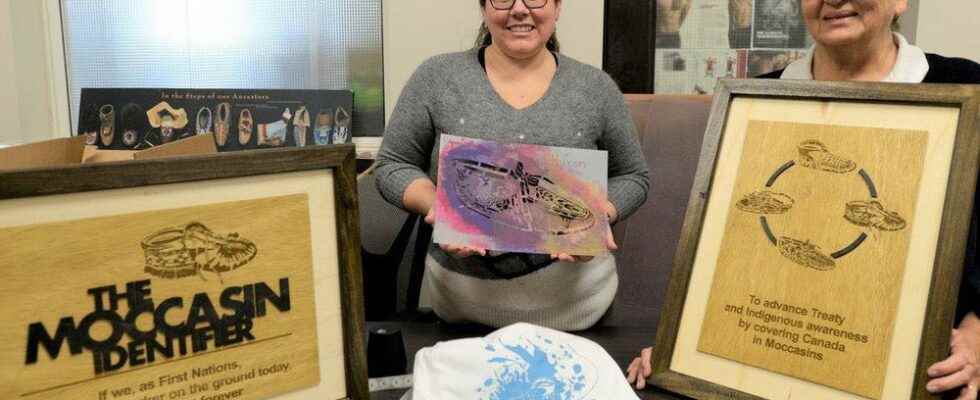
Carolyn King wants to cover Canada in moccasins.
Stencil moccasins, to be precise.
King, a historian and former chief of Mississaugas of the Credit First Nation (MCFN), created the Moccasin Identifier project in 2011 to educate Ontarians about Indigenous culture and treaty rights.
Since then, imprints of traditional First Nations moccasins have popped up at public art installations, crosswalks, heritage trails, hospitals, downtown buildings, parks and college campuses from Toronto to Haldimand and Norfolk.
“We use the moccasins as the symbol that identifies us and connects us to the land,” King said. “We need to create better understanding of treaties and territories or the knowledge will be lost forever.”
There are four distinctive moccasin designs representing the four First Nations linguistic groups in Ontario—Cree, Anishinaabe, Seneca and Huron-Wendat. The stencils are based on drawings by Indigenous artist Phil Cote, who took his inspiration from traditional moccasins found at the Bata Shoe Museum in Toronto.
Each moccasin tells a story, which King has passed on to tens of thousands of people over the past decade by speaking at schools, workshops and public events.
“It addresses truth and reconciliation, and we’re just one little thing, but it’s a great thing that I believe is going to change our world,” King said of the project.
Port Dover Harbor Museum curator Katie Graham said the half-dozen moccasin identifiers found inside the museum nicely complement a display about Indigenous fishing on Lake Erie prior to European settlement.
“We’re proud to include the Moccasin Identifier project in our net shanty, recognizing that Indigenous people were the first to fish Lake Erie,” Graham said.
The project offers free curriculum resources for Grades 1 to 8 on its website, MoccasinIdentifier.com, and sells craft kits that include all four stencils and information on the moccasins’ design and the nations they represent.
“A two-year-old who can reach the table can stencil. It’s easy and fun,” King said. “They get to stencil and they put it somewhere (at home), and it starts to create the conversation.”
Demand for moccasin identifiers is “growing exponentially,” said King, with requests coming in from school boards, municipalities, conservation authorities, libraries and businesses that want to incorporate Indigenous education in their physical spaces and programming.
To meet that demand, Mississaugas of the Credit recently secured $497,900 in community infrastructure funding from the Federal Economic Development Agency for Southern Ontario.
Now ensconced in an office in the band council administration complex, King has help from two newly hired employees to compile educational tool kits to help teachers deliver the program. There are plans for a course to teach teachers how to instruct their students about First Nations and allay concerns King has heard from non-Indigenous educators about cultural appropriation.
The money will also be used to purchase equipment to laser-cut the stencils in house and develop a marketing plan.
“Ontario’s going to be covered with moccasin identifiers in the next decade,” King said.
“They will forever know whose land they’re on.”
JP Antonacci is a Local Journalism Initiative reporter based at the Hamilton Spectator. The program is funded by the Government of Canada.
